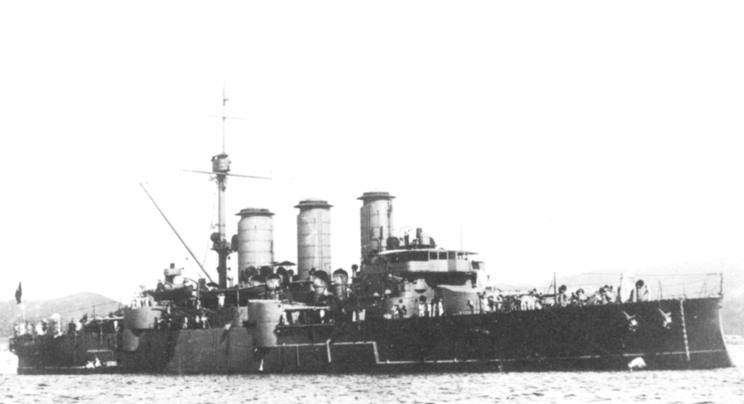|
Even before Italy and Germany were at war "officially" the German navy was attacking and sinking Italian ships. One such case was the loss of the cruiser Amalfi on July 7, 1915. She was built at Odero-Terni-Orlando in Sestri Ponente, Italy and launched on May 5, 1908. One of two Pisa class armored cruisers she carried four 10"/45 (254mm) and eight 7.5"/45 (190mm) as her heavy armament, she was also armed with three 17.7" (450mm) torpedo tubes. Her two triple expansion engines could provide over 20,000 HP and a maximum speed of 23.6 knots for the 10,000 ton ship. On her last day above the waves Amalfi was part of a reconnaissance in force which patrolled the northern Adriatic. The squadron was about 20 miles off Venice at daybreak, in the distance to her east a submarine sat on the surface unseen by the men on Amalfi, perhaps due to the rising sun. The submarine however clearly noticed the Italian ships, the boat submerged and took up a firing position. Looking through the periscope of SMS UB-14 was Oberleutnant zur See Heino von Heimburg, his only other victim to date was the Italian submarine Medusa, sunk on June 10, 1915, the first known instance of a submarine sinking another submarine, he now intended to add a heavy surface ship to his credit. UB-14 was initially identified as KuK U-XXVI, this was of course a disguise as Germany and Italy were not at war until Aug. 27 of the following year, but Austria and Italy were at war so no formal complaint would be made to the German government for the sinking. Von Heimburg fired a single torpedo, which almost brought his boat to the surface, at the largest ship and shortly thereafter an explosion ripped open the port side of Amalfi. The damage was more than the crew could overcome and the ship was ordered to be abandoned. On the stern it was reported that the captain, before telling his men to jump, stood and shouted "Long live the King, Long live Italy" after which the crew repeated the cry and then went over the side. The other ships in the squadron picked up about 500 men, but about 70 men went down with the ship. During the sinking one man was pulled into the propellers and had his arm cut off, the ship's doctor, seeing the man in distress, swam over to him and used his belt as a tourniquet to stop the bleeding. The doctor stayed with the man holding him up until they were rescued. Many (if not all) of the survivors were formed into a artillery battery and later in the month were sent to the Isonzo River front along the border, over the course of the war a number of battles were fought between the Italians and the Austrians in this area, and the Italians took the brunt of the casualties. It has been said that of the 600,000 Italians killed in the Great War fully half of them were lost along the Isonzo, it is safe to assume some of the men from Amalfi were among the casualties. |
© 2012 Michael W. Pocock MaritimeQuest.com |
 |
Amalfi, date and location unknown. |